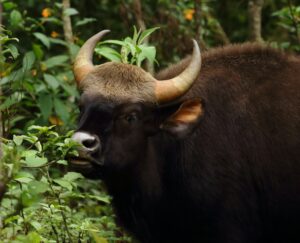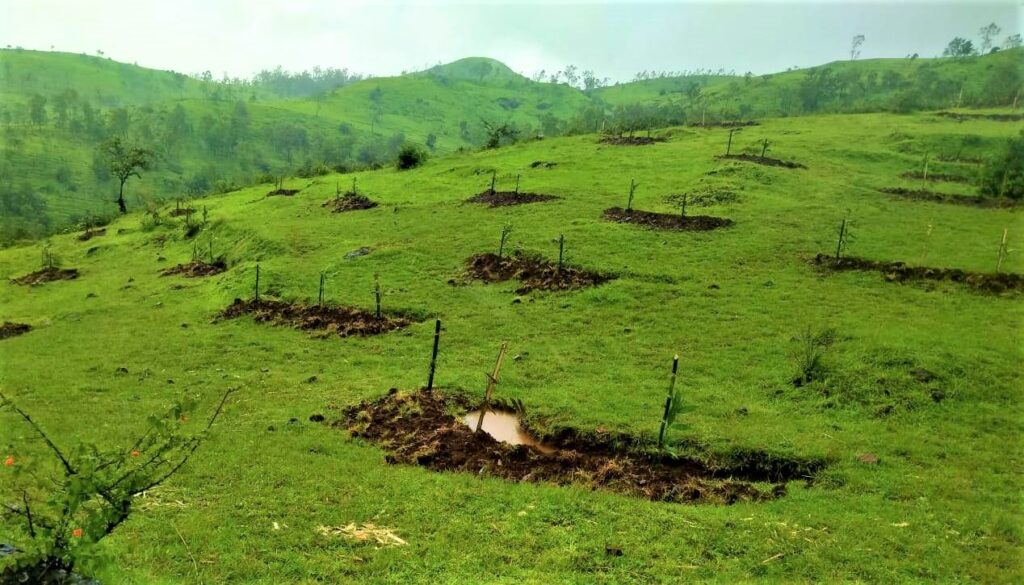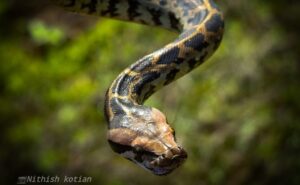

Velhe is a taluka place 60 kms from Pune. When the landowners of a village land at Hirpodi village at Velhe decide to restore the land and create a community forest, FORREST took up the challenge.
This land is located ½ km from the village, at an elevation of 760 mt from MSL on a small hillock. It was denuded of any vegetation apart from seasonal grasses and few shrubs. For restoration, biggest hurdle was no availability of water source on the immediate land. There is a seasonal spring nearby which flows in the monsoon. There is another spring down the hill which is perennial but away from the land.
We decided to work on water and forestry both fronts for habitat restoration.
We planned contour trenches and planting of drought tolerant native species for restoration. Trenching is one of the major environmental engineering measures for water conservation and soil erosion control in non-arable lands. It mainly helps in slope stabilization.
The area with steep slope e.g. hilly region, are prone to soil erosion due to lack of vegetative cover. Velhe is high rainfall area but as the land is on hill, there is “high rainfall, quick drainage” that provides little retention time to the runoff to infiltrate into the soil. Trenching addresses all these issues by increasing infiltration of rainwater, reducing water runoff, reducing soil loss, increasing the ground water level, and facilitating water conservation for vegetation.
Also, vegetation cover is vital as trees stabilize the soil, prevent soil erosion, enhance the land’s capacity to store water, and moderate air and soil temperatures.Selection of the trees is the key to the survival, thus native, local trees which are drought tolerant were carefully selected for planting. Native forest trees are strong and are adapted to adverse natural conditions.
All these native trees have been carefully selected with properties of-
2.Grow locally at Velhe area
7.Will support wildlife-birds, butterflies, small mammals
Plants selection and procurement was a crucial part. Native, drought tolerant local trees were to be carefully selected.
Next step was marking of trenches all over the hill.
250 Contour Trenches were dug, all over the project land.
530 trees were planted over bunds of these trenches. Three trees per trench were planted, in general. All of these are medicinal trees, and most have edible fruits. Many like Reetha (soapnut), Baheda ( Terminalia bellerica), Harad (Termialia chebula) and many others will produce fruits with economical value.
For restoration, trees are also required to provide food and habitat for declining birds-mammals populations. As pressures increases steadily from growing human populations and climate change, we need to consider trees which can support biodiversity also. Ficus trees are natural to this region. Ficus are also keystone species. It means ficus provides year-round, food source to birds, insects, and mammals, even in drought conditions. Thus 200 ficus species were planted, which will lead to fruiting of trees throughout the year and which will support rich biodiversity down the years.
Each plant was helped with compost and other soil additives containing beneficial microbes and supported by bamboo.
We found a part of area, on slope, where soil erosion was much more pronounced (It was “Gulley erosion’). Hillsides are more prone to gullying when they cleared of vegetation, through deforestation or over-grazing or forest fires. To arrest this soil erosion, we covered a small patch with dense plantation.
Making of trenches and planting trees involved lots of transport of materials and supplies – transport of plants, transport of compost and soil nutrient mixture, transport of bamboos, transport of thorny bushes for fence, uphill. This arduous task was carried out by villagers of Hirpodi. Almost 40 villagers came to work with us on all the days.
Making fence was especially tough as enough thorny bushes were not available on the site. Thus, thorny bushes were collected from nearby hills and were transported by tying and dragging these uphill. Thorny fence was created to secure the plants from free grazing cattle.
As in prevailing Covid conditions, village meeting was not possible, we had to find ways to ensure villager’s participation which in turn leads to project sustainability. We took few steps to ensure village participation-
Now all the trenches are filled with rain water and plants are singing in rains.
In near future, we will see the transformation from barren hill to restored forest and biodiversity. The trees we planted over the land will be starting point for a stable ecosystem in some time. This will bring long term positive changes in water, soil, and biodiversity in the larger area.

She conceptualized FORREST to conserve, to Inspire and to connect people back to nature. Her interest lies in Habitat ecology. A poet by nature with a touch of the wild.


We plan to restore a forest of 20000 trees in the monsoon of July 2021! And we need your help to do that! Contribute saplings in Vruksh Khosh or donate Rs. 50 per sapling.